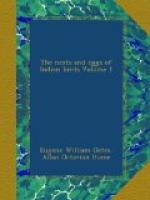I have never met with the nest of the Grey-headed Myna myself, but am indebted to Mr. Gammie for its eggs and nest. That gentleman says:—“I obtained a nest of this species near Mongphoo (14 miles from Darjeeling), at an elevation of about 3400 feet. The nest was in the hollow of a tree, and was a shallow pad of fine twigs, with long strips of bark intermingled in the base of the structure, and thinly lined with very fine grass-stems. The nest was about 4 inches in diameter and less than 11/2 inch in height exteriorly, and interiorly the depression was perhaps half an inch deep. It contained four hard-set eggs.”
This year he writes to me:—“The Grey-headed Myna breeds about Mongphoo, laying in May and June. I have taken several nests now, and I found that they prefer cleared tracts where only a few trees have been left standing here and there, especially on low but breezy ridges, at elevations of from 2500 to 4000 feet. They always nest in natural holes of trees both dead and living, and at any height from 20 to 50 feet from the ground. The nest is shallow, principally composed of twigs put roughly together in the bottom of the hole. They lay four or five eggs.
“The Grey-headed Myna is not a winter resident in the hills. It arrives in early spring and leaves in autumn. It is very abundant on the outer ranges of the Teesta Valley, and is generally found in those places frequented by Artamus fuscus. It feeds about equally on trees and on the ground, and a flock of 40 or 50 feeding on the ground in the early morning is no unusual sight.”
Mr. J.R. Cripps, writing from Fureedpore, Eastern Bengal, says:—“Very common from the end of April to October, after which a few birds may be seen at times. I cannot call to mind ever having seen these birds descend to the ground. They must nest here, though I failed to find one. In front of my verandah was a large Poinciana regia, in the trunk of which, and at about seven feet from the ground, was an old nest-hole of Xantholaema which a pair of these birds widened out. During all May and June I watched these birds pecking away at the rotten wood and throwing the bits out. They generally used to engage in this work during the heat of the day; and, although I several times searched the hole, no eggs were found; the pair were not pecking at the decayed wood for insects, for I watched them through a glass. Had I remained another month at the factory most likely they would have laid during that time; it was on this account their lives were spared. This species associates with its congeners on the peepul trees when they are in fruit, which they eat greedily.”
Subsequently detailing his experiences at Dibrugarh in Assam, he adds:—“On the 27th May I found a nest with three callow young and one fresh egg. The birds had excavated a hole in a rotten and dead tree about 18 feet from the ground, and had placed a pad of leaves only at the bottom of the hole. They build both in forest as well as the open cultivated parts of the country.”




